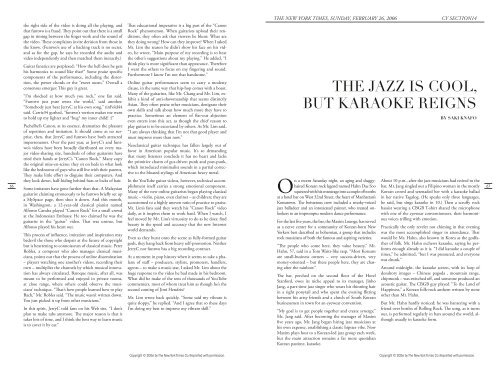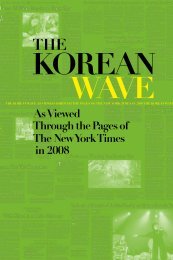The Korean Wave 2006 - Korean Cultural Service
The Korean Wave 2006 - Korean Cultural Service
The Korean Wave 2006 - Korean Cultural Service
You also want an ePaper? Increase the reach of your titles
YUMPU automatically turns print PDFs into web optimized ePapers that Google loves.
66<br />
the right side of the video is doing all the playing, and<br />
that funtwo is a fraud. <strong>The</strong>y point out that there is a small<br />
gap in timing between the finger work and the sound of<br />
the video. <strong>The</strong>se complaints invite derision from those in<br />
the know. (Funtwo’s use of a backing track is no secret,<br />
and as for the gap, he says he recorded the audio and<br />
video independently and then matched them inexactly.)<br />
Guitar fanatics are perplexed: “How the hell does he gets<br />
his harmonics to sound like that?” Some praise specific<br />
components of the performance, including the distortion,<br />
the power chords or the “sweet outro.” Overall a<br />
consensus emerges: This guy iz great.<br />
“I’m shocked at how much you rock,” one fan said.<br />
“Funtwo just pure ownz the world,” said another.<br />
“Somebody just beat JerryC at his own song,” tinFold44<br />
said. Carrie34 gushed, “funtwo’s version makes me want<br />
to hold up my lighter and *hug* my inner child! :)”<br />
Pachelbel’s Canon, at its essence, dramatizes the pleasure<br />
of repetition and imitation. It should come as no surprise,<br />
then, that JerryC and funtwo have both attracted<br />
impersonators. Over the past year, as JerryC’s and funtwo’s<br />
videos have been broadly distributed on every major<br />
video-sharing site, hundreds of other guitarists have<br />
tried their hands at JerryC’s “Canon Rock.” Many copy<br />
the original mise-en-scène: they sit on beds in what look<br />
like the bedrooms of guys who still live with their parents.<br />
<strong>The</strong>y make little effort to disguise their computers. And<br />
they look down, half-hiding behind hats or locks of hair.<br />
Some imitators have gone further than that. A Malaysian<br />
guitarist claiming erroneously to be funtwo briefly set up<br />
a MySpace page, then shut it down. And this month,<br />
in Washington, a 12-year-old classical pianist named<br />
Alfonso Candra played “Canon Rock” for a small crowd<br />
at the Indonesian Embassy. He too claimed he was the<br />
guitarist in the “guitar” video. That was untrue, but<br />
Alfonso played his heart out.<br />
This process of influence, imitation and inspiration may<br />
bedevil the those who despair at the future of copyright<br />
but is heartening to connoisseurs of classical music. Peter<br />
Robles, a composer who also manages classical musicians,<br />
points out that the process of online dissemination<br />
– players watching one another’s videos, recording their<br />
own – multiplies the channels by which musical innovation<br />
has always circulated. Baroque music, after all, was<br />
meant to be performed and enjoyed in private rooms,<br />
at close range, where others could observe the musicians’<br />
technique. “That’s how people learned how to play<br />
Bach,” Mr. Robles said. “<strong>The</strong> music wasn’t written down.<br />
You just picked it up from other musicians.”<br />
In this spirit, JerryC told fans on his Web site, “I don’t<br />
plan to make tabs anymore. <strong>The</strong> major reason is that it<br />
takes lots of time, and I think the best way to learn music<br />
is to cover it by ear.”<br />
That educational imperative is a big part of the “Canon<br />
Rock” phenomenon. When guitarists upload their renditions,<br />
they often ask that viewers be blunt: What are<br />
they doing wrong? How can they improve? When I asked<br />
Mr. Lim the reason he didn’t show his face on his video,<br />
he wrote, “Main purpose of my recording is to hear<br />
the other’s suggestions about my playing.” He added, “I<br />
think play is more significant than appearance. <strong>The</strong>refore<br />
I want the others to focus on my fingering and sound.<br />
Furthermore I know I’m not that handsome.”<br />
Online guitar performances seem to carry a modesty<br />
clause, in the same way that hip-hop comes with a boast.<br />
Many of the guitarists, like Mr. Chang and Mr. Lim, exhibit<br />
a kind of anti-showmanship that seems distinctly<br />
Asian. <strong>The</strong>y often praise other musicians, denigrate their<br />
own skills and talk about how much more they have to<br />
practice. Sometimes an element of flat-out abjection<br />
even enters into this act, as though the chief reason to<br />
play guitar is to be excoriated by others. As Mr. Lim said,<br />
“I am always thinking that I’m not that good player and<br />
must improve more than now.”<br />
Neoclassical guitar technique has fallen largely out of<br />
favor in American popular music. It’s so demanding<br />
that many listeners conclude it has no heart and lacks<br />
the primitive charm of gut-driven punk and post-punk,<br />
which introduced minimalist sounds in a partial corrective<br />
to the bloated stylings of American heavy metal.<br />
In the YouTube guitar videos, however, technical accomplishment<br />
itself carries a strong emotional component.<br />
Many of the new online guitarists began playing classical<br />
music – violin, piano, even clarinet – as children; they are<br />
accustomed to a highly uneven ratio of practice to praise.<br />
Mr. Lim’s fans said they watch his “Canon Rock” video<br />
daily, as it inspires them to work hard. When I watch, I<br />
feel moved by Mr. Lim’s virtuosity to do as he does: find<br />
beauty in the speed and accuracy that the new Internet<br />
world demands.<br />
Even as they burst onto the scene as fully-formed guitar<br />
gods, they hang back from heavy self-promotion. Neither<br />
JerryC nor funtwo has a big recording contract.<br />
At a moment in pop history when it seems to take a phalanx<br />
of staff – producers, stylists, promoters, handlers,<br />
agents – to make a music star, I asked Mr. Lim about the<br />
huge response to the video he had made in his bedroom.<br />
What did he make of the tens of thousands of YouTube<br />
commenters, most of whom treat him as though he’s the<br />
second coming of Jimi Hendrix?<br />
Mr. Lim wrote back quickly. “Some said my vibrato is<br />
quite sloppy,” he replied. “And I agree that so these days<br />
I’m doing my best to improve my vibrato skill.”<br />
<strong>The</strong> New York Times, sunday, february 26, <strong>2006</strong><br />
<strong>The</strong> Jazz Is Cool,<br />
but Karaoke Reigns<br />
On a recent Saturday night, an aging and shaggyhaired<br />
<strong>Korean</strong> rock legend named Hahn Dae Soo<br />
squeezed with his entourage into a couple of booths<br />
at a hotel bar on West 32nd Street, the heart of Manhattan’s<br />
Koreatown. <strong>The</strong> boisterous crew included a smoky-voiced<br />
jazz balladeer and an intoxicated painter, who treated onlookers<br />
to an impromptu modern dance performance.<br />
For the last five years, the bar, the Maxim Lounge, has served<br />
as a nerve center for a community of <strong>Korean</strong>-born New<br />
Yorkers best described as bohemian, a group that includes<br />
rock musicians of both the famous and aspiring varieties.<br />
“<strong>The</strong> people who come here, they value beauty,” Mr.<br />
Hahn, 57, said in a Tom Waits-like rasp. “Most <strong>Korean</strong>s<br />
are small-business owners – very success-driven, very<br />
money-oriented – but these people here, they are chasing<br />
after the rainbow.”<br />
<strong>The</strong> bar, perched on the second floor of the Hotel<br />
Stanford, owes its niche appeal to its manager, Jinho<br />
Jang, a part-time jazz singer who wears his thinning hair<br />
in a tight ponytail and who spent the evening flitting<br />
between his artsy friends and a clutch of South <strong>Korean</strong><br />
businessmen in town for an eyewear convention.<br />
“My goal is to get people together and create synergy,”<br />
Mr. Jang said. After becoming the manager of Maxim<br />
five years ago, Mr. Jang began hiring jazz musicians at<br />
his own expense, establishing a classic hipster vibe. Now<br />
Maxim plays host to a <strong>Korean</strong>-led jazz group each week,<br />
but the main attraction remains a far more quotidian<br />
<strong>Korean</strong> pastime, karaoke.<br />
CY section14<br />
By SAKI KNAFO<br />
About 10 p.m., after the jazz musicians had retired to the<br />
bar, Mr. Jang singled out a Filipino woman in the mostly<br />
<strong>Korean</strong> crowd and serenaded her with a karaoke ballad<br />
in her native Tagalog. (He speaks only three languages,<br />
he said, but sings karaoke in 10.) <strong>The</strong>n a scruffy rock<br />
bassist wearing a CBGB T-shirt shared the microphone<br />
with one of the eyewear conventioneers, their harmonious<br />
voices trilling with emotion.<br />
Practically the only reveler not chiming in that evening<br />
was the most accomplished singer in attendance. That<br />
would be Mr. Hahn, also known in Korea as the godfather<br />
of folk. Mr. Hahn eschews karaoke, saying he performs<br />
enough already as it is. “I did karaoke a couple of<br />
times,” he admitted, “but I was pressured, and everyone<br />
was drunk.”<br />
Around midnight, the karaoke screen, with its loop of<br />
desultory images – Chinese pagoda , mountain range,<br />
chipmunk – was switched off, and someone produced an<br />
acoustic guitar. <strong>The</strong> CBGB guy played “To the Land of<br />
Happiness,” a <strong>Korean</strong> folk-rock anthem written by none<br />
other than Mr. Hahn.<br />
But Mr. Hahn hardly noticed; he was bantering with a<br />
friend over bottles of Rolling Rock. <strong>The</strong> song, as it turns<br />
out, is performed regularly in bars around the world, although<br />
usually in karaoke form.<br />
67<br />
Copyright © <strong>2006</strong> by <strong>The</strong> New York Times Co. Reprinted with permission.<br />
Copyright © <strong>2006</strong> by <strong>The</strong> New York Times Co. Reprinted with permission.





